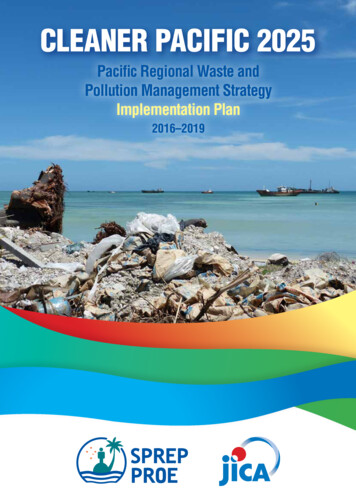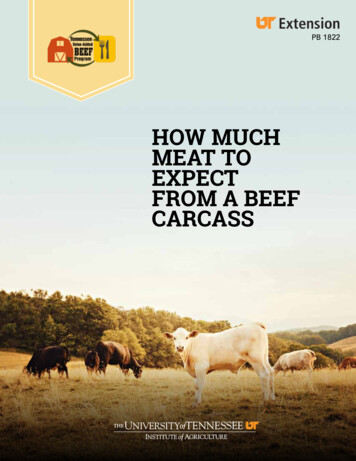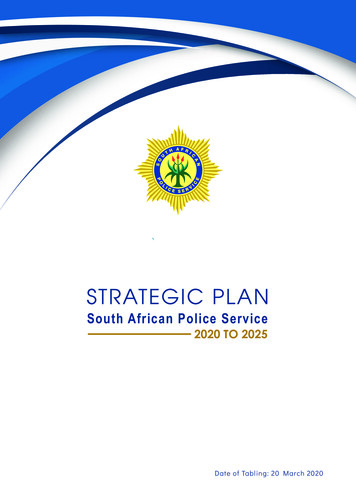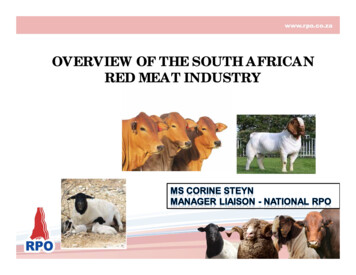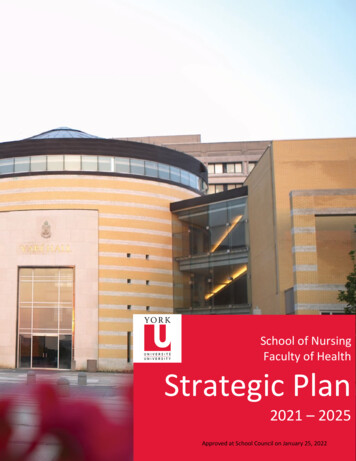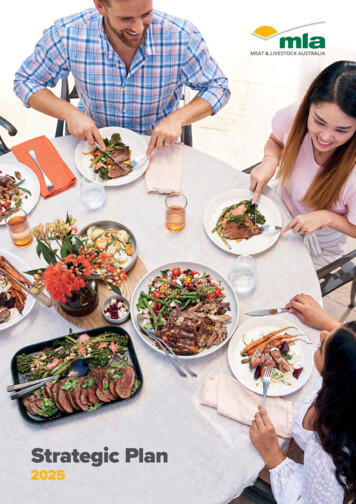
Transcription
Strategic Plan2025
Contents4Chair and MD statements MLA at a glance 6Industry at a glance 8Strategy snapshot 10Creating the strategy 12Assumptions 12Inputs 13What we heard 15Our strategy 16Roadmap 17Guiding principles 18Foundation 19Our strategic focus 21Industry priorities 34Financials 42Corporate governance framework 44Appendices 46 Meat & Livestock Australia 2020ABN 39 081 678 364This work is copyright. Apart from any usepermitted under the Copyright Act 1968, allrights are expressly reserved. Requests forfurther authorisation should be directed to theCorporate Publications and CommunicationsManager, PO Box 1961 North Sydney NSW 2059or info@mla.com.auPublished June 2020This report is printed on ecoStar , anenvironmentally responsible paper made carbonneutral and the fibre source is FSC Recycledcertified. ecoStar is manufactured from 100%post consumer recycled paper in a processchlorine free environment under the ISO 14001environmental management system.MLA Strategic Plan 2025 3
MD’sstatementAs we finalise our Strategic Plan for the next five years, there are both incredibleopportunities and challenges rarely seen before. We also have the benefit of morethan 20 years of operations at MLA to guide us on how and where we can make thegreatest impact.We have to be bold to meet the challenges, take advantageof the opportunities and set our sights on deliveringtransformational change for the industry.Whilst we have taken a whole‑of‑supply chain approach,producers, as key stakeholders, continue to be at the heartof all of our decisions.With a new whole‑of‑industry strategic plan in place, Red Meat2030, there is an opportunity for MLA to drive transformationalchange. We have to find ways to support the industry to deliveron its ambitious vision of doubling the value of red meat sales.This strategy outlines how we will support producer profitability,sustainability and global competitiveness by: helping them(and their supply chains) make better decisions informed bydata; addressing industry’s big, complex challenges; improvingthe delivery of essential services and identifying opportunitiesto create and capture value – including new sources ofrevenue and the development of new high value products.As we developed the plan, we looked at the big gains theAustralian red meat and livestock industry has made in thepast few decades.It was easy to identify the key high‑impact initiatives thathave played a major role in transforming our industryand providing a solid foundation to build upon. Theestablishment of Australia’s on‑farm assurance, animalidentification and traceability systems is a good example.Thanks to the development and continuous improvement ofthese systems, we have been able to guarantee the integrityof our now 28.5 billion red meat industry to our customers.Other examples include Meat Standards Australia, the world’sleading eating quality grading program for beef, and the workto support access to international markets, which has beencritical to the growth and competitiveness of our industry.What these examples show us is to have real impact, weneed to be focused, ambitious with our expectations anddemand greater impact from the investments we make withand on behalf of the red meat industry. This approach iscaptured in the ‘fewer, bigger, bolder’ statement that is partof the way we will operate to execute this plan.We also heard this from our stakeholders, who want ourstrategy to be ambitious, with clear direction on where wefocus to contribute to the profitability, sustainability and globalcompetitiveness of Australia’s red meat and livestock industry.And that is exactly what this strategy does. It statesthe deliberate and bold choices being made to delivermaximum impact. It does this by defining the challenges andopportunities, showing where and how we will focus ourefforts and what success will look like in 2025.As you will see from the guiding principles on page 18, wehave not just focused on what we will do, but how we will doit. This strategy will not sit on a shelf. It will undergo constantreview and refresh during its five‑year lifespan, informed byinsights and meaningful consultation with our stakeholders.Collaboration with stakeholders will be key to delivering onour strategic objectives. Using the industry’s Red Meat 203010‑year strategic plan as our foundation ensures that weare aligned with the vision and priorities shared across thesupply chain.4MLA Strategic Plan 2025To support the strategy, investment will be increased across:Adoption and extensionTo maximise the impact from every investment, programs willhave clear adoption and extension pathways from inception.This will ensure that producers can successfully implementpractical research and development solutions. This strategysees a significant increase in the funds allocated to adoptionand extension activities, consistent with the goal of increasingthe percentage of project funding in Red Meat 2030.Programs that support our integrity systems.Increased investment in this area highlights the importanceof strengthening existing systems in support of biosecurity,food safety and traceability. It also highlights the importanceof activities that accelerate data capture and supportcustomer end‑to‑end supply chain verification requirementsand knowledge transfer within the supply chain to supportbusiness decision making.There is also an emphasis on ensuring MLA investmentscontribute to a socially, environmentally and economicallysustainable Australian red meat industry.Programs of work that help producers adapt to climatevariability, adopt Carbon Neutral 2030 (CN30) pathways andsupport animal health and welfare will strengthen productivity.Investment in these areas will ensure we can achieve asustainable global competitive advantage, demonstratedthrough on‑farm practice change.We are pursuing ambitious outcomes in this strategy.However, the success will ultimately be measured byproducers’ – our levy payers – ability to create and captureadditional value from the investments we make.I look forward to working closely with our levy payers, andother stakeholders to realise this value and, together, builda stronger and more prosperous industry.Jason StrongManaging DirectorChair’sstatementThe MLA Strategic Plan 2025 was created with the purpose of delivering tangible valuefor Australia’s red meat and livestock producers, over the next five years and beyond.As a producer, I challenged the leadership team to ensurethat the MLA purpose was front and centre throughout thedevelopment of this strategic plan, which is:To foster the long‑term prosperityof the Australian red meat andlivestock industry, by collaboratingwith stakeholders to investin research, developmentand marketing initiativesthat contribute to producerprofitability, sustainability andglobal competitiveness.I am pleased to present a plan that recognises theimportance of working together with the supply chainand the other red meat service providers to deliver onthis purpose.The importance of balanceIt has been a difficult few years for many production regions.Long‑term dry and drought conditions, the Queenslandfloods and 2019/2020 bushfires have resulted in historiclows in herd and flock numbers.In addition, the disruption caused by COVID‑19 outbreakwill mean that most of Australia’s key red meat marketsface significant economic slowdown or recession duringthe early years of this plan. The channel and demand shiftwill continue to test carcase balance and profitability andhighlights the importance of maintaining and leveraginga diversified portfolio of markets. However, despite thisdisruption, long‑term demand for high quality, safe andnutritious food is set to continue to grow.This is particularly important within the context of a new meatindustry strategic plan – Red Meat 2030 – with its ambitiousvision of doubling the value of Australian red meat sales asthe trusted source of the highest quality protein.Meaningful collaborationTo help achieve this vision, it is vital that MLA works closelytogether with the other red meat service providers, thepeak industry councils and across the supply chain. Thedevelopment of this strategic plan began with the whole ofindustry plan, Red Meat 2030. However, an important part ofthe process has been sharing information with and listeningto our stakeholders.In taking a co‑design approach to this Strategic Plan, wewere able to explore the cattle, sheep and goat supplychain priorities for the next five years, and understand MLA’srole in helping to address these. It was pleasing to see theimportance of collaboration was something that all of ourstakeholders acknowledged. You can read more about thethemes we heard during the consultation process on page 15.I’d like to acknowledge everyone involved throughout theconsultation process, from producers and brand ownersthrough to research and commercial partners. Everyworkshop, conversation and meeting has provided valuablecontributions to this strategy.As we look to 2025, I am confident that MLA will deliveroutcomes that contribute to a prosperous industry, onewhere decisions are made collectively and whereprofitability and sustainability go hand-in-hand.Alan BeckettChairIn this highly dynamic and complex operating environment,it is more important than ever to strike a balance betweenmanaging and responding to short‑term issues and planningaround long‑term strategic priorities.That ‘balance’ is reflected in this plan, which focuses onboth strengthening the core activities that underpin thesuccess and competitiveness of our industry – such asintegrity systems, market access and global marketing –and on addressing the more complex challenges includingproductivity and climate variability.This approach ensures that MLA’s investments over the nextfive years build on our solid successes but also allow usto be bold and pursue activities that will ensure the futureprofitability, sustainability and global competitiveness ofthe industry.MLA Strategic Plan 2025 5
MLAat a glanceMLA is a Rural Research and Development Corporation and the declared industrymarketing body and the industry research body under sections 60(1) and 60(2) of theAustralian Meat and Live‑stock Industry Act 1997.Our purposeTo foster the long‑termprosperity of the Australianred meat and livestockindustry, by collaboratingwith stakeholders to investin research, developmentand marketing initiativesthat contribute to producerprofitability, sustainabilityand global competitiveness.6MLA Strategic Plan 2025Our membersMembership of MLA is voluntary and free to all levy‑paying grassfed cattle,grainfed cattle, sheep, lamb and goat producers. At the time of publication,there were 49,600 MLA members.Our stakeholdersOur subsidiary companiesMLA works in partnership with industry andgovernment to deliver products and services to thecattle, sheep and goat industries, and other entitiesalong the supply chain.MLA owns two operating subsidiary companies.Our stakeholders include red meat and livestockproducers, the Australian Government’s Departmentof Agriculture, Water and the Environment, peakindustry councils, red meat Rural Research andDevelopment Corporations (RDCs), research partnersand commercial and other supply chain participantsand groups.Peak industry councils are bodies prescribed by theAustralian Government and provide policy directionon behalf of the red meat and livestock industry.These are the Australian Lot Feeders’ Association,Cattle Council of Australia, Goat Industry Council ofAustralia and Sheep Producers Australia.MLA also works closely with the Australian MeatProcessor Corporation, Australian Meat IndustryCouncil, LiveCorp and Australian Livestock Exporters’Council to develop programs that address keyindustry issues and opportunities through the supplychain, manage projects and communicate outcomes.MLA Donor Company (MDC) partners withorganisations to co‑invest in innovation andnew technologies which bring value to the redmeat industry.Integrity Systems Company (ISC) is responsible fordelivering the red meat industry’s on‑farm assuranceand through‑chain traceability programsOur fundingMLA is primarily funded by transaction levies paidon livestock sales by red meat producers. TheAustralian Government also contributes a dollarfor each levy dollar MLA invests in research,development and adoption (RD&A).Other funding streams come from specificunmatched grants from the Australian Governmentand cooperative funding contributions fromother RDCs, individual processors, wholesalers,foodservice operators and retailers.Processors and livestock exporters also co‑investlevies into MLA programs through their servicecompanies – Australian Meat Processor Corporationand Australian Livestock Export Corporation(LiveCorp).Exporters and importers can also co‑invest withMLA on marketing activities.MLA generates additional income via eligiblecommercial funding contributions that are matchedby the Australian Government. This funding isinvested in research and development partnershipsthat benefit the Australian red meat industry throughMDC. ISC also receives additional income viathe sale of National Vendor Declaration productsand the Livestock Production Assurance programaccreditation fee.MLA Strategic Plan 2025 7
Industryat a glance80,000 businesses 28.5 billionacross the red meatsupply chain in 2017–18in red meat salesin 2018–19Domestic sales and export receipts2.4 million 17.2 billionhead live exportedin 2019in export receiptsfor 2018–19Cattle: 1.3 millionSheep: 1.1 millionGoats: 16,059Boxed red meat: 13.5 billionLive exports: 1.8 billionCo‑products/further processing: 1.95 billion 11.3 billion405,000 peoplein domestic salesin 2018–19employed acrossthe red meat supplychain in 2018–19Beef: 8.8 billionLamb: 2.5 billion8MLA Strategic Plan 2025*All figures in AUDMLA Strategic Plan 2025 9
Strategy snapshotOur objectivesTo help double the value of Australian redmeat sales, product must meet or exceedconsumer needs and the focus be on wherewe have a competitive advantage.To become the trusted source of the highestquality protein, the focus should be on productquality and product attributes, including animalhealth, welfare and environmental credentials.Our purposeTo foster the long‑term prosperity of theAustralian red meat and livestock industry,by collaborating with stakeholders to invest inresearch, development and marketing initiativesthat contribute to producer profitability,sustainability and global competitiveness.Our guiding principles–Connecting the supply chain throughalignment with Red Meat 2030–Focusing on delivering impact through‘fewer, bigger, bolder’ programs of work–Maximising impact by connecting programsand R&D investments to customer, consumerand community insights and establishingclear adoption or extension pathwaysat inception–Our investments contribute to a socially,environmentally and economicallysustainable Australian red meat industry–Taking a continuous improvement approachto the delivery of essential services–Our strategy and programs undergo aconstant cycle of review, refresh and informthat includes meaningful consultation withour stakeholders10MLA Strategic Plan 2025To achieve our objectives, we will focus onThis means MLA willSuccess will beDecisions informed through data and insightsTransitioning to a culture that captures and shares data acrossevery point in the supply chain. This will enable the identificationof the highest value opportunities and a shared understanding ofchallenges that need addressing.Prioritise investments that allow for the seamless transfer ofinformation through a national data platform.More producers with access to data and feedback on animalperformance to inform production decisions.Invest in our people, providing them with the skills and confidenceto interpret and use integrated data to drive their decision-making.Industry has a data culture, with supply chain decisions based ondata capture and analysis.Targeted investment to address the industry’s big,complex challengesPrioritising which challenges to address by the impact they coulddeliver for the industry.Have a focused and targeted investment portfolio.Producers have the capability to adopt R&D outcomes that directlyimprove their productivity and profitability.Our starting point will be exploring mechanisms to optimiseresources and address seasonal and climate variability.Invest in the strengthening of our integrity systems, demonstratingthe important role of red meat in a sustainable food system.Collectively, we can then make more informed, strategic decisionsand align responses for greatest impact.Increase investment in and explore new approaches to produceradoption around areas such as adaption to climate variability,reproduction, mortality and objective measurement.We will also continue our focus on meeting the expectations ofcustomers, consumers and the community around animal health,animal welfare and environmental stewardship.Enabling new sources of revenueIdentifying new sources of revenue to capture value and increaseprofitability, alongside red meat production.Objective measures of animal welfare for live export, feedlot andextensive production systems implemented, with an increase inpractice change.Progress towards net zero carbon emissions goal by 2030.Strengthened perception of Australian production practices, acrossdomestic and international markets.Identify opportunities and explore business models aroundthe provision of services and reward mechanisms for goodenvironmental stewardship.Invest in partnerships across the supply chain and acrosssectors, to identify high value opportunities for the conversion ofproduction waste into valuable products.Developing new, high value products that allow us to maximisethe whole carcaseDiversifying products to drive growth through new usages andoccasions for red meat.Improved market specification compliance across defined quality,animal health and other value based pricing dimensions.Identify opportunities to capture value and increase producerprofitability through product and market diversification.Across the supply chain, additional sources of revenue through newbusiness models have been enabled.More producers have diversified their revenue to includeservice offerings.More producers and brand owners diversify revenue earned fromcommodity to higher value products.Customers and consumers globally value Australian red meat as aquality ingredient.Currently 20% of the carcase delivers 80% of the value and weneed to shift this balance, including by transforming what iscurrently considered waste attracting little or no value into highvalue products or ingredients.Beyond today’s farm gateBalancing the current ‘known’ challenges and opportunities andanticipating the future issues industry will face.Capture and apply valuable insights from beyond the farmgate and outside food in order to mitigate risks and enhancesustainability and global competitiveness.We need to foster a culture that looks both to the future and toadjacent industries to inform today’s decision making.Strengthen collaboration with current and new partners to achieveefficiencies and impact.Strengthening our coreContinuing to invest in the essential services which underpin thecompetitiveness of our industry, specifically our integrity systems,market access, nutrition and domestic and international marketingand promotion activities.Continue to invest in the development and delivery of our essentialservices and seek to achieve efficiencies in these activities tomaximise our return on investment.Support market growth and market diversification withinvestments prioritised by market, channel and segmentattractiveness.Support market access, including alleviation of technicaltrade barriers.Share knowledge with commercial supply chain participants tosupport development of branded and high value products.Improvement in the rate of return to total capital for beef andsheep farms.Cross‑sectoral projects and projects funded by external investmentaccount for a growing share of MLA’s investment portfolio.Enhanced project management and milestone delivery.Australian red meat occupies a preferred status amongst customers,consumers and governments.Contribution towards red meat sales value growth and 2030industry target.Contribution to improving preferential access to key markets and tothe industry 2030 target of a 1b reduction in technical trade barriers.Integrity systems are globally competitive, easy to use, and valuedby industry, with increased rates of compliance.Producers are confident in the MLA Strategic Plan and understandthe social, environmental and economic impact and value ofMLA investments.MLA Strategic Plan 2025 11
Creatingthe strategyInputsRed Meat 2030The MLA Strategic Plan 2025 uses the Australianred meat industry’s 10-year strategic plan,Red Meat 2030, as its foundation.In developing this strategy, MLA has made deliberate, bold choices on how todeliver the greatest impact; by defining what challenges need to be addressed,where to focus efforts and how to measure success.Developed over 10 months, Red Meat 2030 involvedconsultation with approximately 300 stakeholders,including producers, representatives from prescribedindustry bodies, state farming and representativeorganisations, customers and community members.As reflected in our guiding principles on page 18,this strategy focuses not just on what we do buthow we do it.Red Meat 2030 describes a shared vision anddirection for the industry: Together, to double thevalue of Australian red meat sales as the trustedsource of the highest quality protein.Whilst we have taken a whole‑of‑supply chainapproach to our strategy, producers are at the heartof all of our decisions.Like Red Meat 2030, MLA employed a design-ledapproach to consultation and strategy development.Divergent and convergent thinking was used to openup and explore problems and opportunities and tothen identify and refine solutions to address them.The plan was developed from our data and insights,consideration of the current and future operatingenvironment, consultation with our stakeholdersand input from a number of key sources.Key to meeting the shared vision and outcomes willbe the translation and application of the industrystrategy across the supply chain.AssumptionsLevy incomeMLA’s Strategic Plan 2025 will begin in a period ofhistoric lows in herd and flock numbers, due to thelong term dry and drought conditions. In the initialyears of the plan, reduced herd and flock numberswill impact on MLA’s income derived from levies.Herd and flock rebuild will occur, with speed andscale largely determined by seasonal factors, visibleproductivity and profitability gains and prevailingeconomic conditions.Budget deficit will likely see increased competitionfor scarce government funds. Additional scrutinyon the impact of levy and matched RD&A investmentis possible.CompetitorsOn‑farm productivity performance remains belowthe productivity improvements being achievedby Australia’s major international competitors.These competitor productivity gains are expectedto continue to outpace growth in Australian redmeat production.Our competitors will continue to strengthen integritysystems in support of market access gains.12MLA Strategic Plan 2025The plan also identifies six priorities to guideactivities for whole of industry benefit and to monitorprogress: our people; our customers, consumersand communities; our livestock; our environment;our markets; and our systems.The MLA Strategic Plan 2025highlights MLA’s contributiontowards Red Meat 2030within the context of the redmeat and livestock producerswe serve and our purposeas a Rural Research andDevelopment Corporation. Itsets out our strategic directionand investment priorities thatwill contribute to producerprofitability, sustainability andglobal competitiveness.Australian Government prioritiesFood securityFood security will rise in importance presentingmarket, channel and segment risks and opportunities.MarketsThe global economy, and most of Australia’s key redmeat markets, are facing a significant slowdown orrecession in the early years of this plan.Long‑term demand for high quality, safe andnutritious food is set to continue to grow, withrate largely determined by income growth indeveloping markets.Customers and consumersAbility to demonstrate biosecurity controls andproduction of safe food and other benefits importantto customers and consumers, will increase inimportance over the life of the plan, supported byverified country of origin or provenance claims.EnvironmentThe role of red meat as part of a sustainable foodsystem will continue to be challenged. Policymakers, customers, consumers and communitymembers will seek evidence of commitment tosustainable practices.Through its Science and Research Priorities and the Rural Research, Development and Extension (RD&E)Priorities, the Australian Government sets high‑level priority objectives covering community, industry andenvironmental concerns. MLA has considered these priorities in the development of this Strategic Plan.Science & Research PrioritiesRural RD&E PrioritiesFoodAdvanced technology; to enhance innovation of products, processes andpractices across the food and fibre supply chains through technologies such asrobotics, digitisation, big data, genetics and precision agriculture.Soil and WaterTransportCybersecurityEnergyResourcesAdvanced ManufacturingEnvironmental ChangeHealthBiosecurity; to improve understanding and evidence of pest and diseasepathways to help direct biosecurity resources to their best uses, minimisingbiosecurity threats and improving market access for primary producers.Soil, water and managing natural resources; to manage soil health, improvewater use efficiency and certainty of supply, sustainably develop newproduction areas and improve resilience to climate events and impacts.Adoption of R&D; focusing on flexible delivery of extension services thatmeet primary producers’ needs and recognising the growing role of privateservice delivery.Consideration was also given to the discussion questions raised in the Department of Agriculture, Water andthe Environment’s 2019 paper – Modernising the Research and Development Corporation system.Under its funding agreement with the Australian Government, MLA is required to conduct an independentperformance review. Recommendations from the Independent Review of MLA Performance 2016–2020 werekey considerations in the development of this plan.MLA Strategic Plan 2025 13
Current and futureoperating environmentThe Australian red meat and livestock industryoperates in a dynamic environment which presentsa variety of opportunities and challenges.MLA used its own data and insights to analysecurrent and longer‑term market and industry trends,as well emerging issues and potential developments,which may affect our operating environment inthe next five years. An examination of political,economic, social, technological environmentaland legal (PESTEL) factors was used to inform ananalysis of strengths, weaknesses, opportunitiesand threats (SWOT). Refer to Appendices –Operating Environment.We also conducted an extensive review of existingreports and data that provide insight on the currentand future operating environment. These includedthe Department of Agriculture, Water and theEnvironment commissioned report AgriculturalInnovation—A national approach to grow Australia’sfuture, the Council of Rural RDC’s Vision 2050 –New thinking about rural innovation in Australia, theNational Farmers’ Federation’s 2030 Roadmap –Australian agriculture’s plan for a 100 billion industry,Food Innovation Australia’s Food and AgribusinessSector Competitiveness Plan 2019 and CSIRO’sAustralian National Outlook 2019.Relevant themes from these reports wereincorporated into our strategy development,including the need to: improve collaboration, targettransformation outcomes, increase innovation uptake,nurture disruptive thinking and the importance ofdata to achieving these.What we heardStakeholder consultationOur stakeholders include red meat and livestockproducers, the Department of Agriculture, Waterand the Environment, peak industry councils, redmeat research and development corporations,research partners, commercial participants and majorpastoral groups.During the consultation process, some common themes emerged. We haveincorporated these themes into the strategic plan.Consultation with stakeholders was a criticalcomponent in the development of the MLA StrategicPlan. Throughout the strategy development, differentmodels were used to ensure we captured their voices.Consultation included co‑design workshops,one‑on‑one meetings and discussions withrepresentatives from across the cattle, sheepand goat industry supply chains to explore theirpriorities and gather input into our strategy. We alsoshared our development process with levy payers,producers and other stakeholders via MLA’s onlinecommunication channels and invited feedback on theemerging themes. Refer to Appendices – Strategydevelopment timeline.“ Collaboration should be meaningful”For both the industry’s Red Meat 2030 plan andMLA’s Strategic Plan 2025 to be successful, weneed to break down silos, working together witha whole‑of‑supply chain approach to addressthe opportunities and challenges we will face.Key to this will be understanding where and howmeaningful collaboration occurs.All of these conversations provided valuablecontributions to our strategy. The priorities, issuesand outcomes from our consultation were consideredin relation to MLA’s purpose, and formed a key inputinto the development of this plan.“ We need to ensure our peopleare our greatest asset”AustralianGovernmentRed Meat 2030vision a nd prioritiesOur peopleOur customers, consumersand communitiesOur livestockOur environmentOur marketsOur systemsRural Research,Development andExtension PrioritiesScienc
The MLA Strategic Plan 2025 was created with the purpose of delivering tangible value for Australia's red meat and livestock producers, over the next five years and beyond. . have played a major role in transforming our industry and providing a solid foundation to build upon. The establishment of Australia's on‑farm assurance, animal


